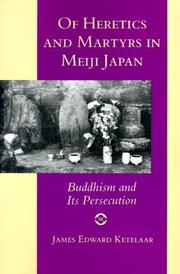| Listing 11 - 18 of 18 | << page >> |
Sort by
|
Book
ISBN: 1684176379 0674267915 Year: 2022 Publisher: Cambridge, Massachusetts : Harvard University Asia Center,
Abstract | Keywords | Export | Availability | Bookmark
 Loading...
Loading...Choose an application
- Reference Manager
- EndNote
- RefWorks (Direct export to RefWorks)
"By analyzing representations of the famous sixteenth-century samurai leader Toyotomi Hideyoshi in historical fiction, this book explores how and why Hideyoshi has had a continued and ever-changing presence in Japanese popular culture. These multiple fictionalized histories reveal a Hideyoshi who is always changing to meet the needs of the current era, expanding our understanding of the powerful role that historical narratives play in Japan"--
Historical fiction, Japanese --- Popular culture --- History and criticism. --- Toyotomi, Hideyoshi, --- Oze, Hoan, --- In literature. --- Japan.
Book
Year: 1942 Publisher: Paris Denoël
Abstract | Keywords | Export | Availability | Bookmark
 Loading...
Loading...Choose an application
- Reference Manager
- EndNote
- RefWorks (Direct export to RefWorks)
Araki, Sadao --- Mitsui family --- Oda, Nobunaga --- Sun, Zhongshan --- Tokugawa, Ieyasu --- Tōyama, Mitsuru --- Toyotomi, Hideyoshi --- Tōgō, Heihachirō

Abstract | Keywords | Export | Availability | Bookmark
 Loading...
Loading...Choose an application
- Reference Manager
- EndNote
- RefWorks (Direct export to RefWorks)
J3357 --- J2284.50 --- Japan: History -- Chūsei -- Azuchi-Momoyama period -- Toyotomi Hideyoshi (1582-1600) --- Japan: Genealogy and biography -- biographies -- Muromachi, Ashikaga, Sengoku and Azuchi-Momoyama periods (1392-1615) --- Generals --- Biography --- Toyotomi, Hideyoshi, --- Feng-chʻen, Hsiu-chi, --- Hideyoshi, --- Toëtomi, Khidėësi, --- Hashiba, Hideyoshi, --- 豊臣秀吉, --- 豐臣秀吉, --- 풍신수길, --- 도요토미 히데요시, --- とよとみ ひでよし, --- 木下秀吉, --- 羽柴秀吉, --- 藤原秀吉, --- Japan --- History --- Fengchen, Xiuji, --- 풍신 수길, --- Toyotomi, Hideyoshi --- 豊臣秀吉
Book
ISBN: 0674390253 Year: 1982 Publisher: Cambridge (Mass.) : Harvard university press,
Abstract | Keywords | Export | Availability | Bookmark
 Loading...
Loading...Choose an application
- Reference Manager
- EndNote
- RefWorks (Direct export to RefWorks)
J3357 --- J2284.50 --- Generals --- -Armed Forces --- Japan: History -- Chūsei -- Azuchi-Momoyama period -- Toyotomi Hideyoshi (1582-1600) --- Japan: Genealogy and biography -- biographies -- Muromachi, Ashikaga, Sengoku and Azuchi-Momoyama periods (1392-1615) --- Biography --- Officers --- Toyotomi, Hideyoshi, 1536?-1598 --- Japan --- History --- -History --- -Generals --- Biography. --- -Japan: History -- Chūsei -- Azuchi-Momoyama period -- Toyotomi Hideyoshi (1582-1600) --- -J3357 --- Nihon --- Nippon --- Iapōnia --- Zhāpān --- I︠A︡ponii︠a︡ --- Yapan --- Japon --- Japão --- Japam --- Mư̄ang Yīpun --- Prathēt Yīpun --- Yīpun --- Jih-pen --- Riben --- Government of Japan --- Toyotomi, Hideyoshi, --- Feng-chʻen, Hsiu-chi, --- Hideyoshi, --- Toëtomi, Khidėësi, --- Hashiba, Hideyoshi, --- 豊臣秀吉, --- 豐臣秀吉, --- 풍신수길, --- 도요토미 히데요시, --- とよとみ ひでよし, --- 木下秀吉, --- 羽柴秀吉, --- 藤原秀吉, --- Fengchen, Xiuji, --- 풍신 수길, --- Toyotomi, Hideyoshi

ISBN: 2213017077 9782213017075 Year: 1986 Publisher: Paris: Fayard,
Abstract | Keywords | Export | Availability | Bookmark
 Loading...
Loading...Choose an application
- Reference Manager
- EndNote
- RefWorks (Direct export to RefWorks)
Au 16e siècle Hideyoshi élevé au rang de chef suprême malgré son origine humble, va rendre au Japon la paix indispensable au progrès et recréer son unité.
Generals --- Biography --- Toyotomi, Hideyoshi --- Japan --- History --- J2284.50 --- J3357 --- -Armed Forces --- Japan: Genealogy and biography -- biographies -- Muromachi, Ashikaga, Sengoku and Azuchi-Momoyama periods (1392-1615) --- Japan: History -- Chūsei -- Azuchi-Momoyama period -- Toyotomi Hideyoshi (1582-1600) --- Officers --- Toyotomi, Hideyoshi, 1536?-1598 --- -J2284.50 --- -Japan: Genealogy and biography -- biographies -- Muromachi, Ashikaga, Sengoku and Azuchi-Momoyama periods (1392-1615) --- -Generals --- Toyotomi, Hideyoshi, --- Feng-chʻen, Hsiu-chi, --- Hideyoshi, --- Toëtomi, Khidėësi, --- Hashiba, Hideyoshi, --- 豊臣秀吉, --- 豐臣秀吉, --- 풍신수길, --- 도요토미 히데요시, --- とよとみ ひでよし, --- 木下秀吉, --- 羽柴秀吉, --- 藤原秀吉, --- Hideyoshi, keizer van Japan. --- Japon. Histoire. 16e s. --- Hideyoshi, empereur du Japon. --- Japan. Geschiedenis. 16e eeuw. --- Fengchen, Xiuji, --- 풍신 수길, --- 960 --- levensbeschrijvingen --- biographies et mémoires --- Generals - Japan - Biography --- Japan - History - Azuchi-Momoyama period, 1568-1603
Book

ISBN: 0870404318 Year: 1978 Publisher: Tokyo Japan culture institute
Abstract | Keywords | Export | Availability | Bookmark
 Loading...
Loading...Choose an application
- Reference Manager
- EndNote
- RefWorks (Direct export to RefWorks)
Japan --- Shōtoku Taishi --- Tenmu --- Kakinomoto no, Hitomaro --- Yamanoue no, Okura --- Ōtomo, Yakamochi --- Kūkai --- Saichō --- Fujiwara no, Michinaga --- Murasaki Shikibu --- Sei Shōnagon --- Taira no, Kiyomori --- Minamoto no, Yoritomo --- Minamoto no, Yoshitsune --- Hōjō, Masako --- Shinran --- Nichiren --- Kusunoki, Masashige --- Ashikaga, Takauji --- Ashikaga, Yoshimitsu --- Ashikaga, Yoshimasa --- Takeda, Shingen --- Oda, Nobunaga --- Toyotomi, Hideyoshi --- Tokugawa, Ieyasu --- Sen no, Rikyū --- Takayama, Justo --- Ihara, Saikaku --- Matsuo, Bashō --- Chikamatsu, Monzaemon --- Arai, Hakuseki --- Motoori, Norinaga --- Tanuma, Okitsugu --- Ryōkan --- Rai, San'yō --- Miura, Meisuke --- Sakamoto, Ryōma --- Ōkubo, Toshimichi --- Shibusawa, Eiichi --- Konoe, Fumimaro --- Tōjō, Hideki --- Kawabata, Yasunari

ISBN: 1568362862 Year: 1999 Publisher: New York Kodansha
Abstract | Keywords | Export | Availability | Bookmark
 Loading...
Loading...Choose an application
- Reference Manager
- EndNote
- RefWorks (Direct export to RefWorks)
Japan --- Biography. --- Mitsui clan --- Iwasaki, Yatarō --- Matsushita, Konosuke --- Tashima, Kazuo --- Honda Soichiro --- Kobayashi, Kōji --- Toyoda, Eiji --- Morita, Akio --- Murasaki Shikibu --- Sen no, Rikyu --- Izumo no, Okuni --- Matsuo, Bashō --- Chikamatsu, Monzaemon --- Katsushika, Hokusai --- Shōtoku Taishi --- Minamoto no, Yoritomo --- Hōjō, Masako --- Minamoto no, Yoshitsune --- Oda, Nobunaga --- Toyotomi, Hideyoshi --- Tokugawa, Ieyasu --- Ōishi Kuranosuke --- Ōkubo, Toshimichi --- Tōjō, Hideki --- Yamamoto, Isoroku --- Hirohito Emperor of Japan --- Yoshida, Shigeru --- Katō, Shidzue --- Tanaka, Kakuei --- Fukuzawa, Yukichi --- Natsume, Sōseki --- Ibuse, Masuji --- Hayashi, Fumiko --- Mishima, Yukio --- Ariyoshi, Sawako --- Kawabata, Yasunari --- Ōe, Kenzaburō --- Ozu, Yasujirō --- Kurosawa, Akira --- Ō, Sadaharu --- Ueshiba, Morihei --- Mitsubishi Group --- Matsushita Electric --- Minolta --- Honda Firm --- NEC --- Toyota Firm --- Sony --- Forty-Seven Ronin --- Iwasaki, Yatarō --- Matsushita, Kōnosuke --- Honda, Sōichirō --- Kobayashi, Kōji --- Sen no, Rikyū --- Matsuo, Bashō --- Shōtoku Taishi --- Hōjō, Masako --- Ōishi, Yoshio --- Ōkubo, Toshimichi --- Tōjō, Hideki --- Hirohito --- Katō, Shidzue --- Natsume, Sōseki --- Ozu, Yasujirō --- Oh, Sadaharu --- Mitsui --- Mitsubishi --- Panasonic --- Honda --- Toyota

ISBN: 0691024812 0691055998 0691221898 Year: 1990 Publisher: Princeton (N.J.) : Princeton university press,
Abstract | Keywords | Export | Availability | Bookmark
 Loading...
Loading...Choose an application
- Reference Manager
- EndNote
- RefWorks (Direct export to RefWorks)
How did Buddhism, so prominent in Japanese life for over a thousand years, become the target of severe persecution in the social and political turmoil of the early Meiji era? How did it survive attacks against it and reconstitute itself as an increasingly articulate and coherent belief system and a bastion of the Japanese national heritage? Here James Ketelaar elucidates not only the development of Buddhism in the late nineteenth century but also the strategies of the Meiji state.
Buddhism --- Japan --- History --- 1868-1945 --- Buddhists --- Persecutions --- Social aspects --- J1800.70 --- J1857 --- J1864 --- J1861 --- J1701 --- J1700.70 --- Japan: Religion -- Buddhism -- history -- Kindai (1850s- ), bakumatsu, Meiji, Taishō --- Japan: Religion -- Buddhism -- apologetics, missionary works, proselytization --- Japan: Religion -- Buddhism -- relation with state and politics --- Japan: Religion -- Buddhism -- relation with Shintō (and Shinbutsu) --- Japan: Religion in general -- policy, legislation, guidelines, codes of behavior --- Japan: Religion in general -- history -- Kindai (1850s- ), bakumatsu, Meiji, Taishō --- Religiöse Verfolgung. --- Buddhismus. --- Buddhism. --- Persecutions. --- Social aspects. --- Japan. --- Aizawa Seishisai. --- Anesaki Masaharu. --- Bureau of Tombs. --- Christianity. --- Confucianism. --- Darwin, Charles. --- Eleven Themes. --- Emperor Jimmu. --- Emperor Komei. --- Eto Shimpei. --- Fujita Toko. --- FukubaBisei. --- Fukuda Gyokai. --- Fukuzawa Yukichi. --- Goi Ranju. --- Han Yu. --- Hirai Kinzo. --- Hirata Atsutane. --- Hirata School. --- Inoue Tetsujiro. --- IshikawaTairei. --- Iwakura Tomomi. --- Juge Shigekuni. --- Kamei Koremi. --- Kikuchi Taketoki. --- Kishimoto Nobuta. --- Kusunoki Masashige. --- Ministry of State (Dajokan). --- Mito. --- Mori Arinori. --- Motoori Norinaga. --- Murakami Senshō. --- Nakai Chikuzan. --- Okubo Toshimichi. --- Okuma Shigenobu. --- Ozu Tetsunen. --- Saigo Takamori. --- Senke Takatomi. --- Seventeen Themes. --- Shibata Reiichi. --- Tanaka Yoritsune. --- Teaching Academies. --- Toyotomi Hideyoshi. --- anti-Buddhist legislation. --- carnivalesque. --- cosmopolitanism. --- decadence. --- festival calendar. --- jinsei. --- national essence. --- temple registration. --- Lamaists --- Religious adherents --- Buddha and Buddhism --- Lamaism --- Ris-med (Lamaism) --- Religions --- Persecution --- al-Yābān --- Giappone --- Government of Japan --- Iapōnia --- I︠A︡ponii︠a︡ --- Japam --- Japani --- Japão --- Japon --- Japonia --- Japonsko --- Japonya --- Jih-pen --- Mư̄ang Yīpun --- Nihon --- Nihon-koku --- Nihonkoku --- Nippon --- Nippon-koku --- Nipponkoku --- Prathēt Yīpun --- Riben --- State of Japan --- Yābān --- Yapan --- Yīpun --- Zhāpān --- Япония --- اليابان --- يابان --- 日本 --- 日本国 --- Jepun --- Yapon --- Yapon Ulus --- I︠A︡pon --- Япон --- I︠A︡pon Uls --- Япон Улс --- Religion --- Buddhist --- Buddhistische Philosophie --- Religionsverfolgung --- Verfolgung --- Glaubensflüchtling --- Prayer-books and devotions --- Tibetan --- I͡Aponii͡ --- Empire du Japon --- Zen-Nihon --- Zenkoku --- Dainihon --- Dainippon --- Japão --- Japaner
| Listing 11 - 18 of 18 | << page >> |
Sort by
|

 Search
Search Feedback
Feedback About UniCat
About UniCat  Help
Help News
News